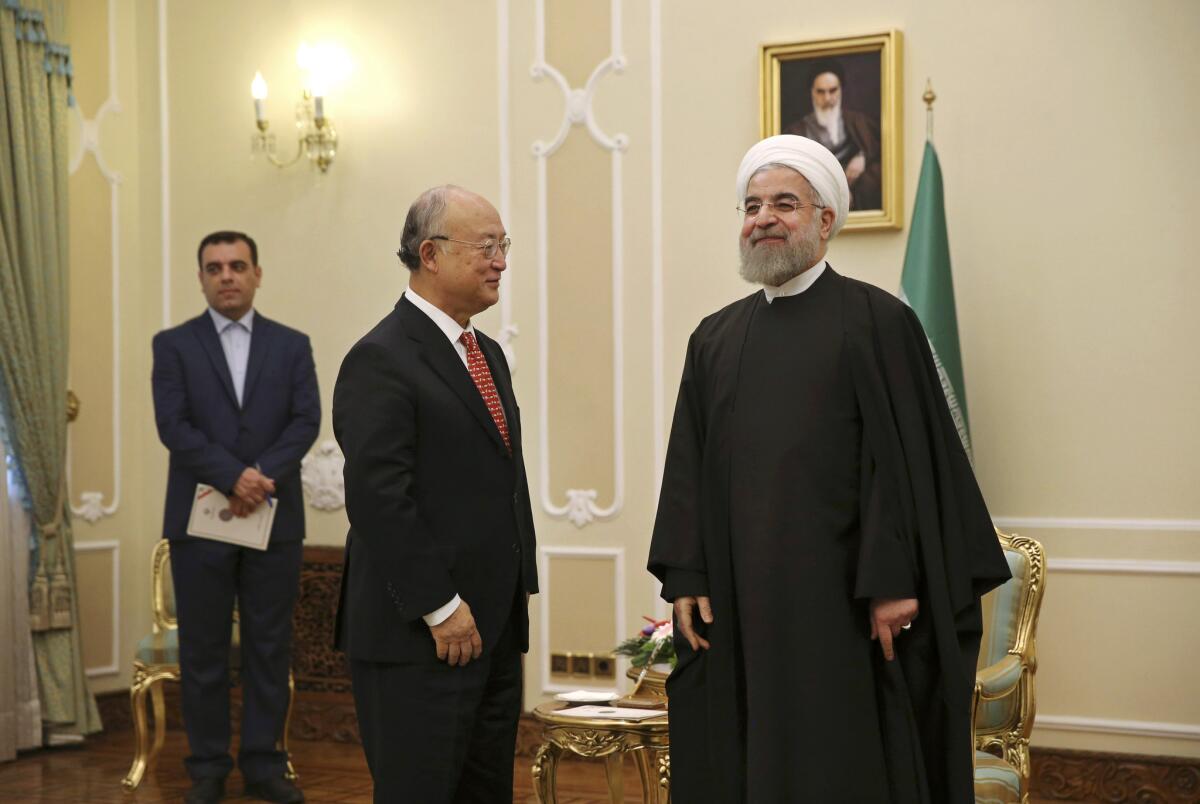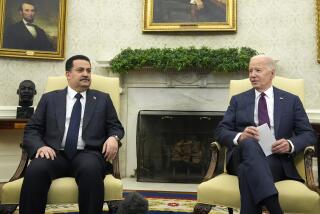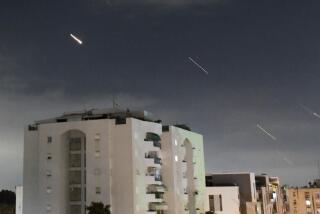IAEA reports ‘significant progress’ in its investigation of Iran’s nuclear activities

Iranian President Hassan Rouhani, right, welcomes U.N. nuclear agency chief Yukiya Amano to a meeting in Tehran on Sept. 20, 2015.
The International Atomic Energy Agency has made “significant progress” in its investigation of Iran’s nuclear activities, the head of the organization said Monday after a weekend visit during which United Nations officials were granted access to the controversial Parchin military site for the first time in nearly a decade.
The visit was important to clarify issues related to a possible military dimension to Iran’s nuclear program, IAEA Director General Yukiya Amano told reporters after briefing the United Nations agency’s board of governors in Vienna.
Amano said he and the agency’s deputy director, Tero Varjoranta, visited a building in Parchin on Sunday that international experts had previously only observed via satellite. Environmental samples were collected from the site before their visit and have been submitted to the IAEA for laboratory analysis, he said.
Amano also held talks with President Hassan Rouhani and other senior Iranian officials, along with members of parliament.
IAEA officials have long sought access to Parchin, a top-secret base east of Tehran where Iran is believed to have tested components that could be used to build an atomic weapon.
The weekend visit was the result of a confidential agreement between the IAEA and Iran in July to answer outstanding questions about the country’s nuclear program.
The IAEA inquiry, which is due in December, will help determine whether international sanctions against Iran are lifted under a broader agreement with six world powers intended to curtail the country’s ability to develop atomic weapons for the next decade or longer.
Iranian officials maintain that their nuclear program was always intended for peaceful purposes, such as electricity generation and the production of medical isotopes.
“Yesterday was an important day in the process of the settlement of Iran’s nuclear issue and, thanks God, the fictions made by ill-wishers against our country about Parchin military site were revealed,” Hamid Baeidinejad, an official at the Iranian Foreign Ministry and one of the country’s nuclear negotiators, was quoted as saying by the semiofficial Fars News Agency.
However, Amano has noted in reports to the IAEA board that extensive construction work carried out at Parchin since early 2012 may have compromised the agency’s ability to conduct effective verification there.
He reiterated the point Monday, saying he and Varjoranta saw indications of recent renovation work at the location they visited Sunday. He did not specify where in the vast military complex that was.
Critics of the deal reached with Iran contend that the IAEA has not been given sufficient access at Parchin to fully investigate the claims of illicit nuclear work being conducted there.
According to some members of Congress, IAEA inspectors are relying on Iranian officials to collect environmental samples at the site, a concession that Sen. Robert Menendez (D-N.J.) has likened to “the fox guarding the chicken coop.”
Iran’s envoy to the IAEA, Reza Najafi, said Monday that Tehran has not allowed any of the agency’s inspectors to visit and take samples at Parchin, or even to supervise their collection by Iranian experts. He characterized Amano’s visit as “ceremonial,” according to Iran’s official Islamic Republic News Agency.
That would be in keeping with a draft of the IAEA’s agreement with Iran viewed by the Associated Press. The document speaks of a visit by Amano not as a part of any IAEA inquiry but as a “courtesy” granted by Iran after the suspect site was investigated for evidence of weapons research, the AP said.
According to the draft, Iranian experts monitored via video and photo cameras would collect their own samples, which they would give to IAEA officials for analysis.
The U.N. agency has declined to release details of its agreements with Iran, in keeping with long-standing procedures intended to encourage countries that are under investigation to cooperate.
Amano confirmed Monday that the Iranians “played a part in the sample-taking process by swiping samples.”
“Authentication by the agency of the samples was achieved through use of an established verification process,” he said without elaborating. “The agency can confirm the integrity of the sampling process and the authenticity of the samples, which were taken at places of interest to the agency at the particular location in Parchin.”
Asked whether the Obama administration was comfortable with the process, White House Press Secretary Josh Earnest said the goal of the international negotiations with Iran was to compel the country to cooperate with the IAEA and its inspections.
“That’s exactly what we’ve seen here,” he said.
For more international news, follow @alexzavis on Twitter
More to Read
Start your day right
Sign up for Essential California for news, features and recommendations from the L.A. Times and beyond in your inbox six days a week.
You may occasionally receive promotional content from the Los Angeles Times.







